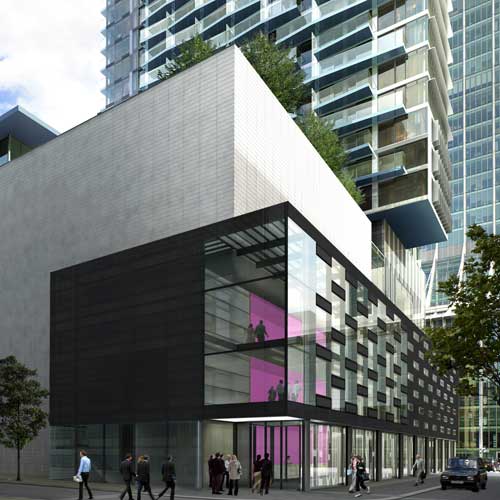How the Guildhall School of Music and Drama is performing on the world stage
Some of the biggest stars have passed through its doors. Now the Guildhall School of Music and Drama has got too big for its roots and is growing a new concert hall and two theatres.

It was 129 years ago that the Guildhall School of Music began life in an unprepossessing former wool warehouse in the City of London. Later it moved to purpose-built premises where, in the 1920s, Fred Astaire and Nol Coward studied the piano. And it wasn't until 1977 that it relocated to its new Barbican home where it has been teaching drama as well as music students, including stars such as Daniel Craig, Ewan McGregor and Orlando Bloom.
Now that it is bursting at the seams, the school is expanding again, alongside its current home in Silk Street. An enormous new structure is about to go up, housing a big 610-seat concert hall, a 225-seat traditional proscenium-arch theatre, another studio theatre, three rehearsal rooms, a TV studio, and teaching space.
According to Professor Barry Ife, its principal, this will give the school world-class facilities to train the most talented performers for the stage and the concert platform, giving it a real edge over similar institutions around the world. "The concert hall will be the first proper concert hall we have had since 1880," he says. "It will be considerably larger than the concert halls of other conservatoires in this country."
Guildhall is fortunate in benefiting from the munificence of the City of London Corporation. Until recently it was entirely funded by the City but recently it came into the state higher education funding system and now receives £3m annually from the Higher Education Funding Council for England (Hefce), as well. The building, which is costing the school £13.5m, is a public/private partnership between the developer, Heron International, the City Corporation and the school. The developer is getting a block of swish flats to sell, which will sit on top of the theatres and concert hall. The development will enable the school to ease the congestion on its current Barbican site, which was built for 340 students but now accommodates 800, and to make its mark on the world stage.
The Guildhall is unique in England in that it is the only conservatoire to teach music, drama and theatre in one institution. But it goes further than this. "We think we are much closer to the professions than other conservatoires," explains Ife. In addition, the school is embedded in a major arts centre (the Barbican) and has a close relationship with the London Symphony Orchestra. "We are as close to the professions as it is possible to get," he adds. "We train as near to industry standards as we can."
The second big project that the school is working on (apart from the new building) is what it calls the "new Barbican campus". It has been given £2.25m by Hefce to create what is being grandly called "the world's leading centre for performance, training and education in the performing arts". This will enable the three partners to develop shared services and joint programmes and will create a Centre for Orchestra, a new initiative in orchestral training, education and career support for young professional musicians.
"We're going to amalgamate back-office functions with the Barbican and the LSO," says Ife. "With the Barbican Centre we're already run off a single finance department and a single engineering maintenance department, and this will continue. What all this adds up to is an original collaboration between a higher education institution and a major international arts centre and an orchestra."
The changes at the Guildhall School of Music and Drama are a sign of the times and reflect developments in the university world as a whole. Universities are becoming more porous, doing deals with outside organisations and making common cause with companies and voluntary groups in an effort to create synergy. This can produce a combined effect greater than the sum of their separate efforts.
Moreover, universities find that it is often easier to collaborate with an outfit that has nothing to do with higher education because there is no competition involved. Rivalry can make cooperation difficult, as Guildhall admits.
Like other higher education institutions Guildhall is expanding at a moment when more money has been coming into the system as a result of tuition fees and there is a corresponding rise in student expectations. As an institution in a global marketplace – half its students come from outside Great Britain – it needs to ensure that it maintains its reputation for excellence.
This appears to be one of the main drivers for its expansion in Silk Street – it needs to be sure that it is providing them with a learning experience that is as good as, if not better than, any they can receive in, say, New York.`
Subscribe to Independent Premium to bookmark this article
Want to bookmark your favourite articles and stories to read or reference later? Start your Independent Premium subscription today.

Join our commenting forum
Join thought-provoking conversations, follow other Independent readers and see their replies